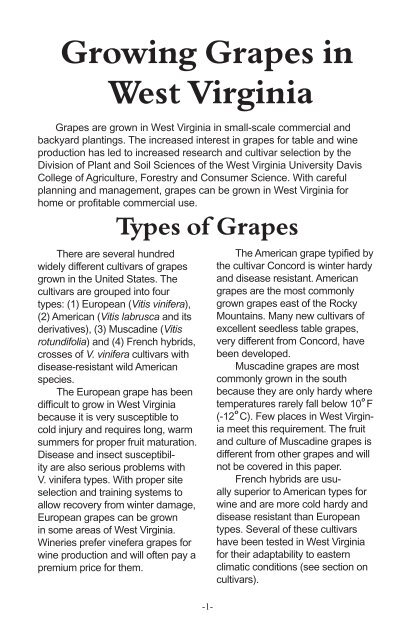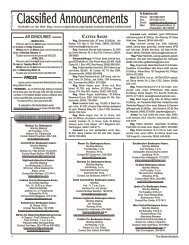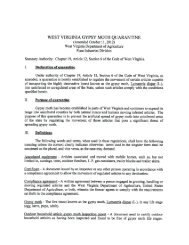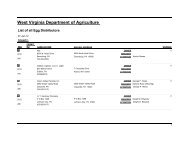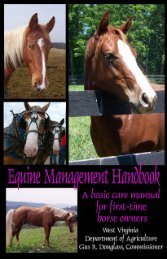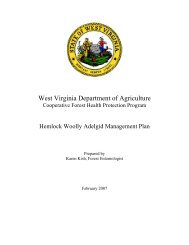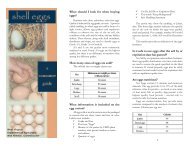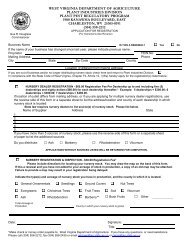Growing Grapes in WV - West Virginia Department of Agriculture
Growing Grapes in WV - West Virginia Department of Agriculture
Growing Grapes in WV - West Virginia Department of Agriculture
Create successful ePaper yourself
Turn your PDF publications into a flip-book with our unique Google optimized e-Paper software.
<strong>Grow<strong>in</strong>g</strong> <strong>Grapes</strong> <strong>in</strong><strong>West</strong> Virg<strong>in</strong>ia<strong>Grapes</strong> are grown <strong>in</strong> <strong>West</strong> Virg<strong>in</strong>ia <strong>in</strong> small-scale commercial andbackyard plant<strong>in</strong>gs. The <strong>in</strong>creased <strong>in</strong>terest <strong>in</strong> grapes for table and w<strong>in</strong>eproduction has led to <strong>in</strong>creased research and cultivar selection by theDivision <strong>of</strong> Plant and Soil Sciences <strong>of</strong> the <strong>West</strong> Virg<strong>in</strong>ia University DavisCollege <strong>of</strong> <strong>Agriculture</strong>, Forestry and Consumer Science. With carefulplann<strong>in</strong>g and management, grapes can be grown <strong>in</strong> <strong>West</strong> Virg<strong>in</strong>ia forhome or pr<strong>of</strong>itable commercial use.Types <strong>of</strong> <strong>Grapes</strong>There are several hundredwidely different cultivars <strong>of</strong> grapesgrown <strong>in</strong> the United States. Thecultivars are grouped <strong>in</strong>to fourtypes: (1) European (Vitis v<strong>in</strong>ifera),(2) American (Vitis labrusca and itsderivatives), (3) Muscad<strong>in</strong>e (Vitisrotundifolia) and (4) French hybrids,crosses <strong>of</strong> V. v<strong>in</strong>ifera cultivars withdisease-resistant wild Americanspecies.The European grape has beendifficult to grow <strong>in</strong> <strong>West</strong> Virg<strong>in</strong>iabecause it is very susceptible tocold <strong>in</strong>jury and requires long, warmsummers for proper fruit maturation.Disease and <strong>in</strong>sect susceptibilityare also serious problems withV. v<strong>in</strong>ifera types. With proper siteselection and tra<strong>in</strong><strong>in</strong>g systems toallow recovery from w<strong>in</strong>ter damage,European grapes can be grown<strong>in</strong> some areas <strong>of</strong> <strong>West</strong> Virg<strong>in</strong>ia.W<strong>in</strong>eries prefer v<strong>in</strong>efera grapes forw<strong>in</strong>e production and will <strong>of</strong>ten pay apremium price for them.-1-The American grape typified bythe cultivar Concord is w<strong>in</strong>ter hardyand disease resistant. Americangrapes are the most commonlygrown grapes east <strong>of</strong> the RockyMounta<strong>in</strong>s. Many new cultivars <strong>of</strong>excellent seedless table grapes,very different from Concord, havebeen developed.Muscad<strong>in</strong>e grapes are mostcommonly grown <strong>in</strong> the southbecause they are only hardy whereotemperatures rarely fall below 10 Fo(-12 C). Few places <strong>in</strong> <strong>West</strong> Virg<strong>in</strong>iameet this requirement. The fruitand culture <strong>of</strong> Muscad<strong>in</strong>e grapes isdifferent from other grapes and willnot be covered <strong>in</strong> this paper.French hybrids are usuallysuperior to American types forw<strong>in</strong>e and are more cold hardy anddisease resistant than Europeantypes. Several <strong>of</strong> these cultivarshave been tested <strong>in</strong> <strong>West</strong> Virg<strong>in</strong>iafor their adaptability to easternclimatic conditions (see section oncultivars).


